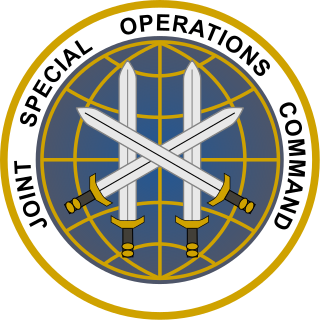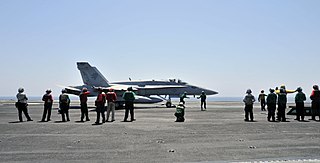
The Joint Special Operations Command (JSOC) is a joint component command of the United States Special Operations Command (USSOCOM) and is charged with studying special operations requirements and techniques to ensure interoperability and equipment standardization, to plan and conduct special operations exercises and training, to develop joint special operations tactics, and to execute special operations missions worldwide. It was established in 1980 on recommendation of Colonel Charlie Beckwith, in the aftermath of the failure of Operation Eagle Claw. It is headquartered at Pope Field.

In response to rapid territorial gains made by the Islamic State during its 2014 Northern Iraq offensives, universally condemned executions, human rights abuses and the fear of further spillovers of the Syrian Civil War, many states began to intervene against it in both the Syrian Civil War and the War in Iraq (2013–2017). These efforts are called the War against the Islamic State, or the War against ISIS. In later years, there were also minor interventions by some states against IS-affiliated groups in Nigeria and Libya. All these efforts significantly degraded the Islamic State's capabilities by around 2019-2020. While moderate fighting continues in Syria, as of 2023, ISIS has been contained to a manageably small area and force capability.

James Wright Foley was an American journalist and video reporter. While working as a freelance war correspondent during the Syrian Civil War, he was abducted on November 22, 2012, in northwestern Syria. He was murdered by decapitation in August 2014 purportedly as a response to American airstrikes in Iraq, thus becoming the first American citizen killed by the Islamic State of Iraq and Syria (ISIS).

Steven Joel Sotloff was an American-Israeli journalist. In August 2013, he was kidnapped in Aleppo, Syria, and held captive by militants from the Islamic State of Iraq and the Levant (ISIS).

Mohammed Emwazi was a British militant of Kuwaiti origin seen in several videos produced by the Islamist extremist group Islamic State of Iraq and the Levant showing the beheadings of a number of captives in 2014 and 2015. A group of his hostages nicknamed him "John" since he was part of a four-person terrorist cell with English accents whom they called 'The Beatles'; the press later began calling him "Jihadi John".

On 22 September 2014, the United States officially intervened in the Syrian civil war with the objective of fighting the Islamic State as part of Operation Inherent Resolve in the international war against the Islamic State. The U.S. also supports the Syrian rebels and the Kurdish-led Syrian Democratic Forces opposed to both the Islamic State and Syrian president Bashar al-Assad.

Beginning in 2014, a number of people from various countries were beheaded by the Islamic State (IS), a radical Sunni Islamist group operating in Iraq and Syria as well as elsewhere. In January 2014, a copy of an IS penal code surfaced describing the penalties it enforces in areas under its control, including multiple beheadings. Beheading videos have been frequently posted by IS members to social media. Several of the recorded beheadings were conducted by Mohammed Emwazi, whom the media referred to as "Jihadi John" before his identification. The beheadings received wide coverage around the world and attracted international condemnation. Political scientist Max Abrahms posited that IS may be using well-publicized beheadings as a means of differentiating itself from Al-Qaeda in Iraq, and identifying itself with Khalid Sheikh Mohammed, the al-Qaeda member who beheaded Daniel Pearl. The publicised beheadings represent a small proportion of a larger number of total people killed following capture by ISIS.
"The Beatles" was the nickname for an Islamic State terrorist group composed of four British militants. The group was named by their hostages after the English rock group The Beatles, who referred to the members as "John", "Paul", "George", and "Ringo".
David Cawthorne Haines was a British aid worker who was captured by the Islamic State of Iraq and the Levant (ISIL) in early 2013 and beheaded in early September 2014.

On 15 June 2014, U.S. President Barack Obama ordered United States forces to be dispatched in response to the Northern Iraq offensive of the Islamic State (IS) as part of Operation Inherent Resolve. At the invitation of the Iraqi government, American troops went to assess Iraqi forces and the threat posed by ISIL.

Operation Inherent Resolve (OIR) is the United States military's operational name for the international war against the Islamic State (IS), including both a campaign in Iraq and a campaign in Syria, with a closely related campaign in Libya. Through 18 September 2018, the U.S. Army's III Armored Corps was responsible for Combined Joint Task Force – Operation Inherent Resolve (CJTF—OIR) and were replaced by the XVIII Airborne Corps. The campaign is primarily waged by American and British forces in support of local allies, most prominently the Iraqi security forces and Syrian Democratic Forces (SDF). Combat ground troops, mostly special forces, infantry, and artillery have also been deployed, especially in Iraq. Of the airstrikes, 70% have been conducted by the military of the United States, 20% by the United Kingdom and the remaining 10% being carried out by France, Turkey, Canada, the Netherlands, Denmark, Belgium, Saudi Arabia, the United Arab Emirates, Australia and Jordan.
Executions by ISIS refers here to killing by beheading, immolation, shooting, or other means of military and civilian people by the Islamic State of Iraq and the Levant (ISIL). ISIL has released a number of propaganda/publicity videos of beheadings or shootings of captives. Houtat Sulūk is reported to be a mass grave.

Kayla Jean Mueller was an American human rights activist and humanitarian aid worker from Prescott, Arizona, United States. She was taken captive in August 2013 in Aleppo, Syria, after leaving a Doctors Without Borders hospital. Media had long reported that a 26-year-old American aid worker was being held by ISIS without naming her, at her family's request. In 2015, she was killed in uncertain circumstances. The operation that killed ISIS leader Abu Bakr al-Baghdadi was named Operation Kayla Mueller, after her.
Abu Sayyaf was the nom de guerre of a senior leader of the Islamic State of Iraq and the Levant (ISIL) who was described as overseeing gas and oil operations. United States authorities identified Abu Sayyaf's real name as Fathi Ben Awn Ben Jildi Murad al-Tunisi. Abu Sayyaf was killed on the night of May 15–16, 2015 while resisting capture during a United States Army Delta Force operation in eastern Syria.

The Turkey–Islamic State conflict refers to a series of attacks and clashes between the state of Turkey and the Islamic State (ISIS), most of which is part of the spillover of the Syrian Civil War. Turkey joined the War against the Islamic State in 2016, after the Islamic State attacks in Turkey. The Turkish Armed Forces' Operation Euphrates Shield was partly aimed against the Islamic State and partly against the SDF. Part of the Turkish occupied zone in northern Syria, around Jarabulus and al-Bab, was taken from the Islamic State.

Joshua Lloyd Wheeler was a United States Army soldier who was killed in Iraq during Operation Inherent Resolve. He was a master sergeant assigned to the elite Delta Force, and was the first American service member killed in action as a result of enemy fire while fighting ISIS militants. He was also the first American to be killed in action in Iraq since November 2011.
Louisa Akavi is a New Zealand Red Cross nurse and recipient of the rarely awarded Florence Nightingale Medal. Akavi was kidnapped in Syria in October 2013 and subsequently taken hostage by Islamic State forces in May 2014. Akavi's captivity remained a tightly held secret by the New Zealand Government and media for the past five years. On 15 March 2019, the International Committee of the Red Cross (ICRC) disclosed her identity following the fall of the Islamic State's last stronghold in Syria. New Zealand Foreign Minister Winston Peters has confirmed that the New Zealand Government is still trying to rescue and bring her home.

The American intervention in the Syrian civil war is the United States-led support of Syrian opposition and the Federation of Northern Syria during the course of the Syrian Civil War and active military involvement led by the United States and its allies — the militaries of the United Kingdom, France, Jordan, Turkey, Canada, Australia and more — against the Islamic State of Iraq and the Levant (ISIL) and al-Nusra Front since 2014. Since early 2017, the U.S. and other Coalition partners have also targeted the Syrian government and its allies via airstrikes and aircraft shoot-downs.











